Greetings from Barcelona!
I’m once again accompanying Nuvia on a work trip to the capitol of Catalonia. I don’t have any events here this time. I’m just working on various projects, drinking lots of coffee, and eating patatas bravas on the daily.
My literary companion for this trip isn’t Roberto Bolaño or Antonin Gaudí but Colm Tóibin. The Irish writer snuck onto my radar with his moving account of the Eaton fire and its devastating impact on the library of the late Gary Indiana. (Faithful readers of Orca Alert! already know what I’m talking about.) Apparently, Tóibin is currently living in Highland Park in NELA. That revelation sent me down a rabbit hole and a few days later a used copy of his book Homage to Barcelona landed in my mailbox.
Tóibin worked as a teacher here and returned in 1988 to write the book and again during the run-up to the 1992 Olympics, a seismic event in the city, the preparations for which helped modernize Barcelona after 36 years of Franco’s rule.
Like so many outstanding Irish writers, Tóibin began as a journalist and he is an excellent guide to Barcelona. One of the things I’ve failed to appreciate about Barcelona during my past visits is that Barcelona is not a Spanish city in much the same way that Belfast isn’t a British city. The Irish and Catalans have centuries-old beef with professional colonizers and Tóibin writes spiritedly about the Catalan imagination:
“This feeling that as intellectuals, humanists, inventors, writers and entrepreneurs they had risen above Spain would never leave Catalan consciousness. They came to believe they had not simply been sailors, but cartographers as well; not merely writers but book collectors and translators; not only merchants and builders, but men of culture, who sought to impose order, peace and a system of law in place of darkness, chaos and piracy. They were, they believed, modern, while Spain was medieval.”
Barcelona was once the most prosperous port in the world, the gem of the Mediterranean, until you-know-who sailed across the ocean blue bringing death and disease to the New World and dishonor to the old one. Barcelona’s peak of power was in the 14th century and the Gothic Quarter is its living testament. Tóibin points out it “is not a crumbling set of medieval buildings, or old ruins being shored up and restored,” but places where people live, work, worship, and, of course, eat and drink.
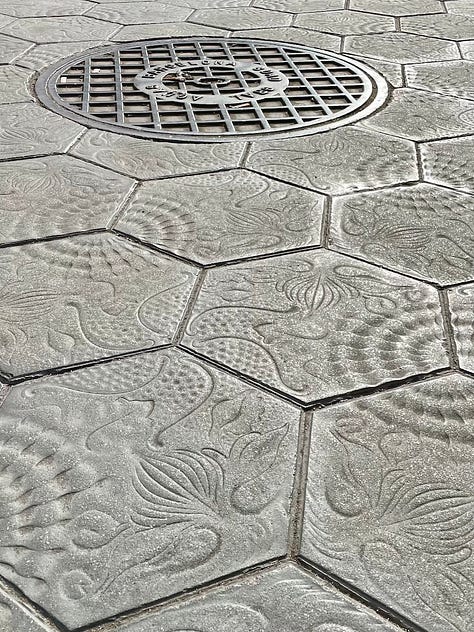
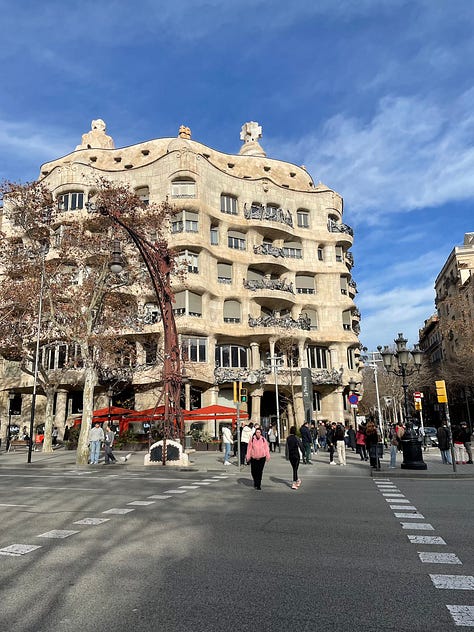
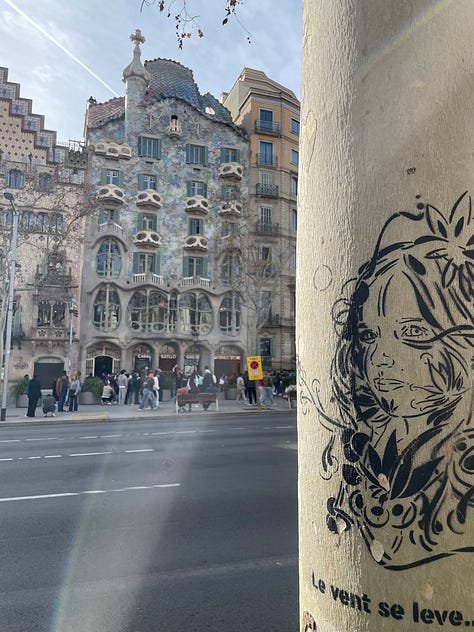
The Catalan concept of modernity is linked to the past. A side effect of dictatorial rule is that people tend to lean into their traditions instead of abandoning them—even if it takes generations. Life is short, but cultural memory is long, a fact that drives fascists up the wall.
There are reminders of this everywhere in Barcelona, especially its architecture, which is marvelous. I’m particularly enamored by Modernisme, an architectural movement dating back to the late nineteenth century that drew from Art Noveau and inspired Gaudí and many of his contemporaries in wildly different ways. Tóibin points out that a section of Passeig de Gràcia where Gaudí’s Casa Battló sits next door to Casa Amattler, which was designed by Josep Puig i Cadafalch, was called:
“Manzana de la Discordia, the block of discordance, owing to its set of ambitious buildings, all of which were designed in a different variation on the Modernista style.”
I don’t want to give the impression that I have suddenly become a student of architecture or anything like that. Mostly what I’ve done in my three days here is eat, drink, stagger around, and look at stuff while trying to stay awake.
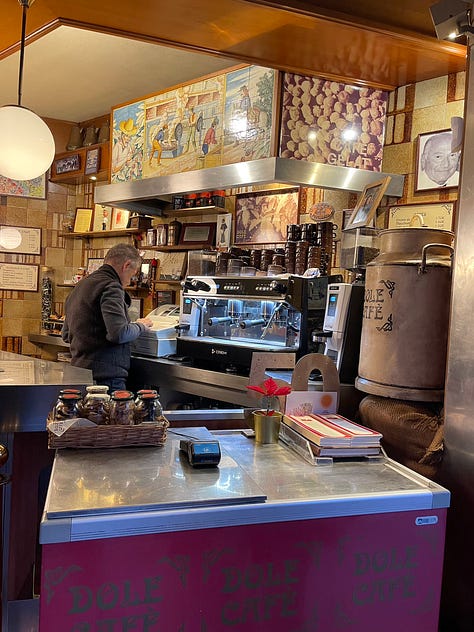
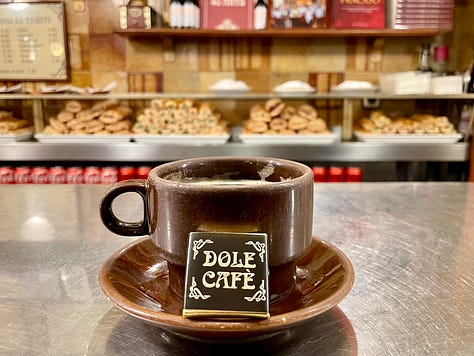
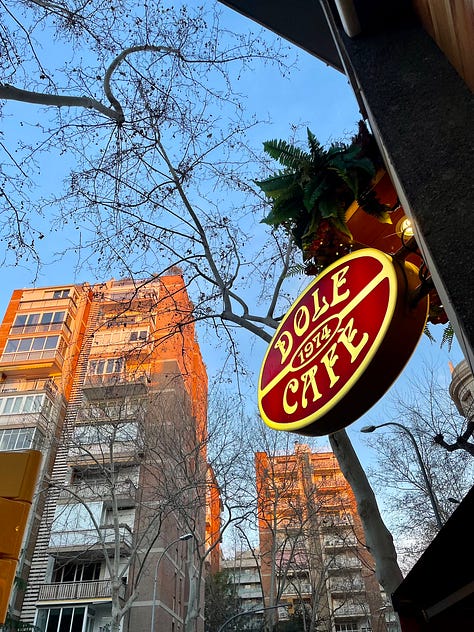
One of our favorite spots in Sarria, the neighborhood where we are staying, is Dole Café, a tiny little restaurant the size of a dining car that’s been in business since 1974. Despite its tiny size all the food and pastries are made on site, including the bread. Many patrons who come here daily never sit down, preferring to stand, drink their coffee while they scarf down a croissant, and go on their way. Some patrons never make it inside, opting for the standing tables outside where they can smoke.
During the morning rush, Dole Café has five employees and they never stop moving. Each has several overlapping duties but are delegated, as near as I can tell, by geography so that they’re not always bumping into each other. The tiny area behind the counter is made ever smaller by a column that must bear a significant load because it’s always in the way. The counterman has to turn his body to the side just to get around it and the side of the column is worn down by the millions of asses that have brushed passed it in the 51 years the place has been in business.
We’ve spent a little over an hour in the place over the course of three days but have made friends with some of the people who stop by around the same time, including a teacher named Laura who has promised to read my books. I’m low-key obsessed with one of the countermen who looks like a young Roberto Bolaño. Maybe he’ll consent to a photograph…
Razorcake Eastside Punks
Razorcake’s celebration of underground punk from the eastside of LA continues with Episode 5: Our Band Sucks. Check it out and then do your part.
Thanks for reading! Are you ready for some interviews? Are you ready to have your minds blows? Because next week will be the first of back-to-back interviews with LA writers with the same first name.
If you liked this newsletter you might also like my latest novel Make It Stop, or the paperback edition of Corporate Rock Sucks: The Rise & Fall of SST Records, or my book with Bad Religion, or my book with Keith Morris. I have more books and zines for sale here. And if you’ve read all of those, consider checking out my latest collaboration The Witch’s Door and the anthology Eight Very Bad Nights.
Message from the Underworld comes out every Wednesday and is always available for free, but paid subscribers also get my deepest gratitude and Orca Alert! on most Sundays. It’s a weekly round-up of links about art, culture, crime, and killer whales.



Mmm! Tóibin's description of the Gothic Quarter really resonates. It's by far my favorite part of that city.🖤Love that you included architecture by Gaudí too! Have you been to Primavera Sound?
I'm enjoying being a subscriber -- I already trust you to take me someplace beautiful with your words. Thank you!🖤
Thanks for this. Brought up many memories of when I lived their many years ago.